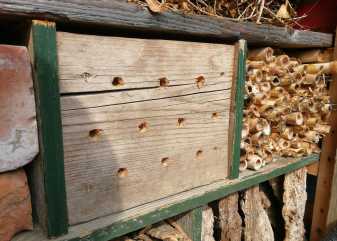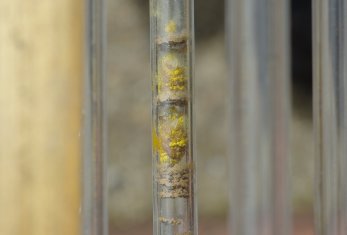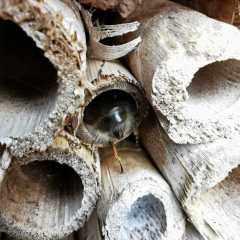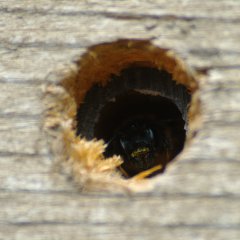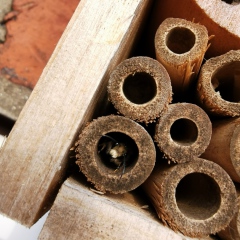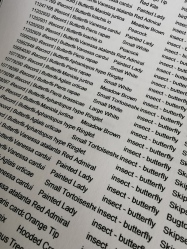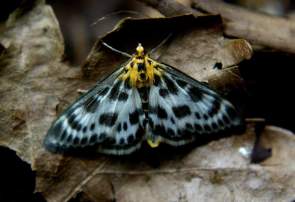Conservation in Action
Our Conservation Work
Solitary Bees, Butterflies and Moths
In the UK we have over 250 species of bees. These consist of 24 bumblebee species, one honeybee species and the rest are made up of solitary bees.
Unfortunately, they face many threats in the UK and around the world today, with a recent European Red List for Bees report showing one in ten UK species is at risk of extinction. In the past 50 years, more than 50% of our bee, butterfly and moth populations have declined. This includes three bumblebee species which have become extinct, 52% of solitary bees have declined, 227 species of moth have declined (with up to 66 species going extinct) while 72% of butterfly species experienced downward trends between 2001-2011.
Some of the biggest threats facing our insects come down to habitat loss. Since the 1930’s, the UK has lost 97% of it’s wildflower meadows, which provide habitat and food for many insects including bees. Intensification of agriculture and increased use of pesticides and herbicides have also had a huge impact, as has the spread of disease in certain species.
What are we doing?
Solitary bees are insects which don’t build “nests” or “hives”. Each one of these bees will mate, and then search for a suitable hole in which to lay their eggs. Eggs are deposited in chambers in each suitable hole, a stock of pollen is prepared within the hole moistened with nectar, and then the adult will seal up the hole with mud, pulped up wood or flower petals. When the egg hatches, the larvae develops in the hole feeding on the nectar and pollen left by the parent. Then when they have finally metamorphosed into a bee, they will leave the hole and the whole cycle starts again!
At Bugtopia Hornsea, we have installed a very large Bug Hotel outside the front of our premises, incorporating a bee friendly design, to support our local solitary bee populations. We also have further bee houses on another site. We are monitoring these annually to see how many bees we have using them, so we can see how the population in this small local area is changing, and so we can hopefully increase the population by providing suitable breeding sites for the adults and suitable incubation sites for the larvae.
We also take part in regular wildlife surveys through iRecord, and submit data every year to The Big Butterfly Count. These surveys help experts to get an idea of what is happening to local, nationwide and global populations, which also give a “pulse” to the state of the environment, habitats and diversity in general across the UK.
Bug Hotel at Freeport Site Data
May 2018-
0 perspex tubes in use, 3 bamboo tubes in use
June 2019-
2 perspex tubes in use, 6 bamboo tubes in use
June 2020-
1 perspex tubes in use, 13 bamboo tubes in use
June 2021-
1 perspex tube in use, 24 bamboo tubes in use
Bee House 1 (Off site location)
May 2018- 24 holes in use
June 2019- 91 holes in use
June 2020-197 holes in use
Bee House 2 (Off site location)
Installed April 2020
June 2020- 62 holes in use
As you can see from this data, the population of bees using our sites has increased year on year. From 2018 to 2019, we saw a 266% increase in usage by solitary bees, and from 2019 – 2020 a 175% increase. We have also observed that the bamboo tubes are a huge favourite compared to the Perspex tubes for our bees. As a result of these findings, we will be changing some sections of our bug hotel to provide more space for bees specifically, to help continue the increase in populations.
Butterfly and Moth Surveys
We carry out wildlife surveys at 2 different locations; Hornsea Freeport and another site in Skipsea and submit this data via iRecord, which feeds into the national database of species records for the UK. The goal of iRecord is to make it easier for wildlife sightings to be collated, checked by experts and made available to support research and decision-making at local and national levels.
How You Can Help Our Bees, Butterflies and Moths!
Bees, butterflies and moths need habitat in order to thrive and survive! You can help by dedicating a part (or all!) or your garden for these incredible insects to thrive in. Encourage the growth of wildflowers and weeds in your garden, keep your lawn long so the grasses and weeds flower, providing food for a huge variety of invertebrates.
You could build or buy a bug hotel like ours to give bees and other bugs somewhere safe to lay their eggs. You can see from our data above that once they find a good spot, word gets about and the population DOES start to increase! They are easily and cheaply available online or quite often at Aldi.
You can also take part in surveys yourself! Download the apps for The Big Butterfly Count and iRecord, and every time you go outside, watch out for various butterflies, moths, bees and other insects and invertebrates, then record them yourself and submit your data!
You can encourage your local communities to leave verges and village greens to grow long, to set aside green spaces for nature to thrive, and encourage others to do the same.
You can also make wise choices when it comes to your food, selecting locally grown, organically produced fruit and vegetables, as these use less harmful chemical in their production too!

